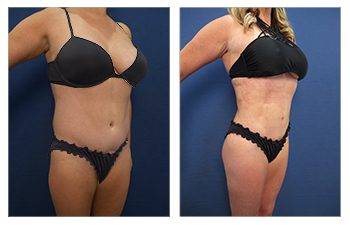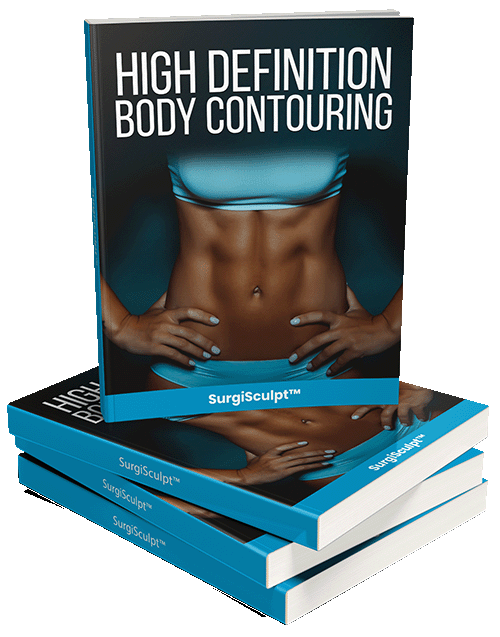



Introduction: Ideal belly button shape with tummy tuck surgery
The most critical component of a successful tummy tuck is the creation of the belly button. This is because the belly button must be released during a tummy tuck to allow for maximum belly skin removal. Following the trimming of redundant skin and the tightening of the muscle, the skin is redraped and then repaired.
At this point, the belly button stalk that was released must be re-insert into the belly skin in order to re-establish a belly button. This process requires making a circular incision in the belly skin and re-establishing an aesthetically appealing belly button shape. This maneuver is referred to as creating a new umbilicus and demands aesthetic beauty and a non-operated looking belly button.
In order to create an ideal belly button shape several conditions must be met. First, the neoumbilicus ring must be sewn to fall inside the belly button shadow rather than on the outside skin where it will be visible to onlookers.
This is accomplished by securing the belly button stalk down to the muscle layer so that when you sew the new belly button ring, the belly skin is pulled down towards the muscle.
When the stalk is sewn down, then it is not as mobile and thus the new ring must be made directly over the stalk, otherwise risking the new ring may not reach the umbilical stalk during the repair.
This maneuver requires the use of an Umbilicator, an instrument pioneered by our own Newport Beach surgeon SurgiSculpt. The Umbilicator is secured on the umbilical stalk prior to redraping the skin and allows your surgeon to feel the stalk in order to ensure the creation of the neoumbilicus accurately directly over the stalk.
Second, the ideal belly button shape dictates the creation of a belly button that is proportional and harmonious with the newly created abdomen. As a tummy tuck specialist, I am referred to unsatisfactory tummy tuck belly button results routinely.
I have observed belly buttons that are both too small and look scarred in appearance as well as belly buttons that are too large in appearance and look like a target.
The ideal belly button diameter will typically range between 1.0 cm and 1.5 cm for the majority of patients. The creation of an ideal belly button is required to achieve high definition tummy tuck results.
This is because the belly button is at the center of the belly and thus most likely to catch the onlooker’s eyes. As a result creation of an ideal belly button shape with a tummy tuck is a necessity for success.
Often, when individuals think of tummy tucks or other abdominal procedures, the primary focus tends to hover around achieving a flat, toned midriff. However, nestled in the center of our stomachs, the belly button, or umbilicus, silently yet significantly influences the overall appearance and perception of our abdomen. Its subtle attributes, such as shape, size, and positioning, can dramatically affect the aesthetic appeal of the entire midsection.
Delving into the Anatomy and Aesthetics of the Umbilicus
The Belly Button: More Than Just a Remnant
Beyond its biological origin as the site of the umbilical cord, the belly button has evolved to become a significant feature that offers character to our abdominal region. When placed and shaped ideally, it can act as a harmonious centerpiece, offering a balanced, proportional appearance to the entire abdomen.
Variations and Modern Aesthetic Ideals
Across the globe, cultures and beauty standards have depicted differing preferences for what constitutes the “perfect” belly button. Some aesthetic ideals lean towards a slightly oval, vertically elongated shape, while others might favor a more discreet, circular, or even “T-shaped” umbilicus. However, a common thread among these varying preferences is the universal agreement that the belly button’s attributes can significantly enhance or mar the beauty of the abdominal area.
Peering Through the Lens of Evolution: The Umbilicus’s Role
Beyond Beauty: The Functional Origins
Historically, the belly button’s primary function was far from aesthetic. Serving as the connection point to the umbilical cord, it was our first conduit for nutrition and sustenance in the womb. However, as humanity evolved, so did our perceptions and associations with this seemingly inconspicuous scar.
Anthropological Insights: The Umbilicus and Social Perceptions
Some anthropologists and evolutionary biologists theorize that the aesthetic appeal of the belly button might have roots in ancient mate selection processes or even tribal social structures. There’s a possibility that certain belly button shapes and placements were subconsciously associated with health, fertility, or social status. Over generations, these ingrained preferences may have subtly influenced our modern-day beauty standards, explaining our continued obsession with the perfect belly button.
Crafting Perfection: Achieving the Ideal Belly Button Shape Through Abdominoplasty
The Nuances of Abdominoplasty and Umbilicoplasty
While abdominoplasty is a broad surgical procedure aiming to contour the abdomen by removing excess skin and tightening muscles, umbilicoplasty specifically targets the reshaping of the belly button. During a comprehensive tummy tuck procedure, the surgeon often melds the principles of both these procedures to not only sculpt the abdomen but also to finesse the belly button’s aesthetics.
Modern Surgical Techniques: A Symphony of Art and Science
With the rapid advancements in medical science and surgical methodologies, today’s plastic surgeons are equipped with an arsenal of techniques. These enable them to make minimal incisions, ensure reduced visibility of post-operative scars, and employ strategies that promote quicker recovery. These refined techniques allow surgeons to craft belly buttons that look natural, are positioned ideally, and align well with the patient’s overall physique and aesthetic preferences.
Post-Surgical Care: Ensuring the Longevity of the Newly Sculpted Belly Button
The First Few Weeks: Crucial Recovery Time
The initial weeks post-surgery are pivotal for the healing of the newly crafted umbilicus. Ensuring the surgical site remains clean, avoiding activities that might exert pressure on the abdomen, and religiously following the surgeon’s post-operative guidelines are crucial. These steps not only promote optimal healing but also ensure that the belly button retains its desired shape and placement.
Long-Term Care: Preserving the Artwork
Once the initial healing phase concludes, it’s vital to remain vigilant about the long-term care of the surgical site. This includes protecting the area from excessive sun exposure (which can darken scars), maintaining a stable weight (as significant weight fluctuations can alter the belly button’s appearance), and regularly monitoring the site for any unexpected changes.
In Conclusion: Creating the ideal belly button with tummy tuck surgery
The belly button, often overlooked in the grander scheme of abdominal aesthetics, holds unparalleled power in influencing the beauty of the midriff. Whether you’re born with an innie an outie, or something in between, it’s essential to recognize and respect the influence this small feature has on the overall abdominal aesthetic. With modern surgical techniques, achieving the dream belly button is no longer a distant dream but a tangible reality. As we move forward in this age of aesthetic enhancements, it’s crucial to approach such procedures with informed knowledge, realistic expectations, and a deep appreciation for the subtle art of belly button beautification.
Here we share the before and after of a 46-year-old female status post abdominoplasty, improving her belly button shape with a tummy tuck.
